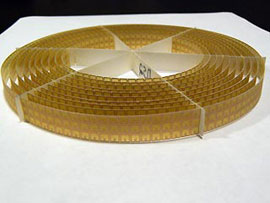|
 |
| A photo of the "metamaterial" cloak, released
to Reuters on October 19, 2006, which deflects microwave beams so
they flow around a "hidden" object inside with little distortion,
making it appear almost as if nothing were there at all. U.S. and
British scientists said on Thursday they had found a way to hide an
object from microwave radiation in a first step toward making a what
they hope will be an invisibility cloak.
[Reuters] |
Scientists are boldly going where only fiction has gone before - to
develop a Cloak of
Invisibility. It isn't quite ready to hide a Romulan space
ship from Capt. James T. Kirk or to disguise Harry Potter, but it is a
significant start and could show the way to more sophisticated
designs.
In this first successful experiment, researchers from the United States
and England were able to cloak a copper
cylinder.
It's like a mirage , where
heat causes the bending of light rays and cloaks the road ahead behind an
image of the sky.
"We have built an artificial mirage that can hide something from
would-be observers in any direction," said cloak designer David Schurig, a
research associate in Duke University's electrical and computer
engineering department.
For their first attempt, the researchers designed a cloak that prevents
microwaves from detecting
objects. Like light and radar waves, microwaves usually bounce off
objects, making them visible to instruments and creating a shadow that can
be detected.
Cloaking used special materials to deflect radar or light or other
waves around an object, like water flowing around a smooth rock in a
stream. It differs from stealth technology, which does not make an
aircraft invisible but reduces the cross-section available to radar,
making it hard to track.
The new work points the way for an improved version that could hide
people and objects from visible light.
Conceptually, the chance of adapting the concept to visible light is
good, Schurig said in a telephone interview. But, he added, "From an
engineering point of view it is very challenging."
The cloaking of a cylinder from microwaves comes just five months after
Schurig and colleagues published their theory that it should be possible.
Their work is reported in a paper in Friday's issue of the journal
Science.
"We did this work very quickly ... and that led to a cloak that is not
optimal ," said co-author
David R. Smith, also of Duke. "We know how to make a much better one."
The cloak is made of metamaterials, which are mixtures of metal and
circuit board materials such as ceramic, Teflon or fiber composite.
In an ideal situation, the cloak and the item it is hiding would be
invisible. An observer would see whatever is beyond them, with no evidence
the cloaked item exists.
(Agencies) |